Irish Brown Bread
It doesn’t get better than a warm slice of Irish Brown Bread served with a slather of butter. Made with wholesome and simple ingredients, you can make this brown bread recipe in under an hour for a deeply rich and nutty bread perfect dipping or dunking in your favorite stew. Perfect for breakfast, lunch, St. Patrick’s day, or those everyday warm bread cravings!
Years ago I made my first loaf of Irish Soda Bread for St. Patrick’s Day and instantly fell in love. I loved the thick, hearty texture and simple, yet complex, flavor. It’s truly a fabulous bread that I have enjoyed over and over since first trying it. After tackling Irish soda bread, I wanted to learn more about Irish brown bread.
I found tons of recipes, all seeming to contradict each other in terms of what makes Irish brown bread truly “authentic”. In the end, it seemed that there was no one set of rules for Irish brown bread and I decided on this version from David Lebovitz, which comes from the chef/owner of Longueville House in Ireland.
I loved this version because it included such a wide variety of flours and grains – all-purpose flour, whole wheat flour, and a combination of wheat bran and wheat germ. It takes the hearty texture of the bread to a whole new level and is absolutely, utterly delicious. I think I am now officially converted to the brown bread version of Irish soda bread – it’s delish!
What is Irish Brown Bread?
If you have been to Ireland, you no doubt have come across this hearty bread. Irish brown bread, also called Irish brown or brown bread, is a traditional Irish bread recipe often served with breakfast and lunch. Many years ago, white flour was more expensive than wheat which meant you were more likely to make or find a loaf of brown bread over Irish soda bread.
How is Irish Brown Bread Different From Irish Soda Bread?
If you really want to get technical, brown bread is a form of soda bread since it uses baking soda as the leavening agent. However, the two loaves differ pretty significantly from there.
- Irish brown bread has a deep, nutty flavor because of its wheat flour and wheat bran while soda bread uses only white flour.
- Soda bread is slightly sweet and more scone-like while Irish brown bread is more savory with a tender interior.
Baking Irish Brown Bread
Made with basic ingredients typically consisting of coarse wheat flour, buttermilk, and baking soda this is truly a pantry-staple recipe. The extra crisp exterior surrounds a dense, but tender, interior for an unforgettable slice of bread.
Gather Your Ingredients
- Flour Mixture – A mix of whole wheat flour, wheat bran, and all-purpose flour come together in this loaf to add a rich, nutty flavor.
- Buttermilk + Baking Soda – The buttermilk helps prevent the bread from drying out during the baking process but also works with the baking soda to leaven the bread.
- Salt – Flavor, flavor, flavor!
- Butter – Cold, unsalted butter cut into small pieces.
- Molasses – Adds a hint of sweetness to the loaf while also adding to the brown color of the bread.
How to Make Irish Brown Bread
- Preheat the oven: Set the oven to 350°F.
- Prepare a baking sheet: Line with parchment paper or a silicone baking mat and put it on the center oven rack.
- Whisk wheat flours: Mix together whole wheat flour and wheat/oat bran with a whisk in a large bowl.
- Whisk dry ingredients: In a medium bowl whisk together all-purpose flour, baking soda, and salt.
- Combine dry ingredients: Add the dry ingredients to the wheat flour mixture and whisk to combine.
- Rub in the butter: Using your fingers, rub the butter pieces into the flour mixture until as small as possible.
- Add liquid ingredients: Stir in buttermilk and molasses until the dough is uniformly damp.
- Knead into a ball: Gently knead the dough on a lightly floured countertop until the dough forms a smooth ball.
- Cross the top: Use a sharp serrated knife (or a lame) to slice a cross 1-inch deep into the bread. Place loaf on the hot baking sheet.
- Bake: Put the loaf in the oven and bake for 30-35 minutes, or until the loaf is firm on top and when you tap the bottom, it feels hollow.
- Cool: Remove from oven and cool on a wire rack for about 1 hour before serving.
Recipe Notes
- Pan for baking: I prefer to use a lined baking sheet for this brown bread recipe but you can also use a seasoned cast-iron skillet.
- Storing: Store fresh baked Irish brown bread in an airtight container at room temperature for up to 3 days after baking.
- Freezing: If you don’t plan on eating your bread right away I suggest freezing the loaf. Wrap the cooled loaf tightly in two layers of plastic wrap and freeze for up to 3 months.
- Reheating: When you are ready to reheat the loaf, remove it from the freezer and allow it to come to room temperature. Pop in the oven and bake at 350°F for 5-10 minutes.
Serving Suggestions
I truly believe you can’t go wrong with toasting a slice of this delicious bread and spreading on a little Irish butter. Some other ways you can indulge in this hearty bread include:
- Serving it alongside a bowl of Guinness Beef Stew
- Toasting some slices and serving alongside Corned Beef Hash
- Top a slice with Irish butter and some homemade Bacon Jam
Other Bread Recipes to Try Next
Irish Brown Bread
You don’t need the luck of the Irish to make this Irish Brown Bread recipe! No yeast, no rise time, and crisp on the outside, tender on the inside every time makes this the only brown bread recipe you will need.
If you make this Irish Brown Bread Recipe and love it, remember to stop back and give it a 5-star rating – it helps others find the recipe! ❤️️
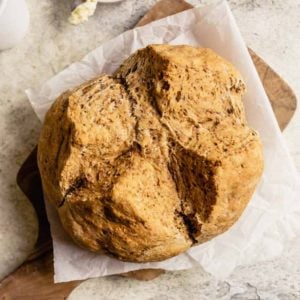
Irish Brown Bread
Ingredients
- 1⅛ cups (127 g) whole wheat flour
- 1⅓ cups (85 g) wheat bran
- 2 cups (240 g) all-purpose flour
- 1 teaspoon (0.75 teaspoon) baking soda
- ½ teaspoon (0.5 teaspoon) salt
- 2 tablespoons (28 g) unsalted butter, cold and cut into small pieces
- 1¼ cups (300 ml) buttermilk
- 2 tablespoons (1 teaspoon) molasses
Instructions
- Preheat oven to 350 degrees F. Line a baking sheet with parchment paper or a silicone baking mat and put it on the center oven rack.
- Whisk together the whole wheat flour and wheat/oat bran or wheat germ in a large bowl.
- In a medium bowl, whisk together the all-purpose flour, baking soda and salt. Add to the wheat flour mixture and whisk to combine.
- Add the butter pieces and rub them into small pieces with the flour mixture using your fingers or a pastry blender, until as small as possible.
- Stir in the buttermilk and molasses until the dough is uniformly damp. Turn out onto a lightly floured countertop and knead gently, until the dough forms a smooth ball.
- Use a sharp serrated knife (or a lame) to slice a cross deeply into the top of the bread, about 1-inch deep. Place the loaf on the hot baking sheet.
- Bake for about 30 to 35 minutes, or until the loaf is firm on top and when you tap the bottom, feels hollow.
- Remove from the oven and cool on a wire rack for about one hour before serving.
Notes
- Equipment: Rimmed baking sheet or cast iron skillet
- Wheat Bran: You can substitute oat bran or wheat germ, by weight.
- Buttermilk: If you do not have buttermilk and can't get it, use this substitution: Place 1½ tablespoons lemon juice or white vinegar in a liquid 2-cup measuring cup. Add enough whole or 2% milk to bring the mixture to 1½ cups. Stir it, then let it sit for 5 minutes before using. Discard ¼ cup to get the correct measurement for this recipe.
- Storing: Store fresh baked Irish brown bread in an airtight container at room temperature for up to 3 days after baking.
- Freezing: If you don't plan on eating your bread right away I suggest freezing the loaf. Wrap the cooled loaf tightly in two layers of plastic wrap and freeze for up to 3 months.
- Reheating: When you are ready to reheat the loaf, remove it from the freezer and allow it to come to room temperature. Pop in the oven and bake at 350°F for 5-10 minutes.
- Recipe adapted from David Lebovitz.
Did you make this recipe?
Leave a review below, then snap a picture and tag @thebrowneyedbaker on Instagram so I can see it!
Photography by Lauren Grant.


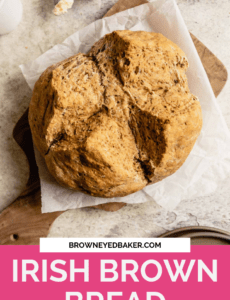
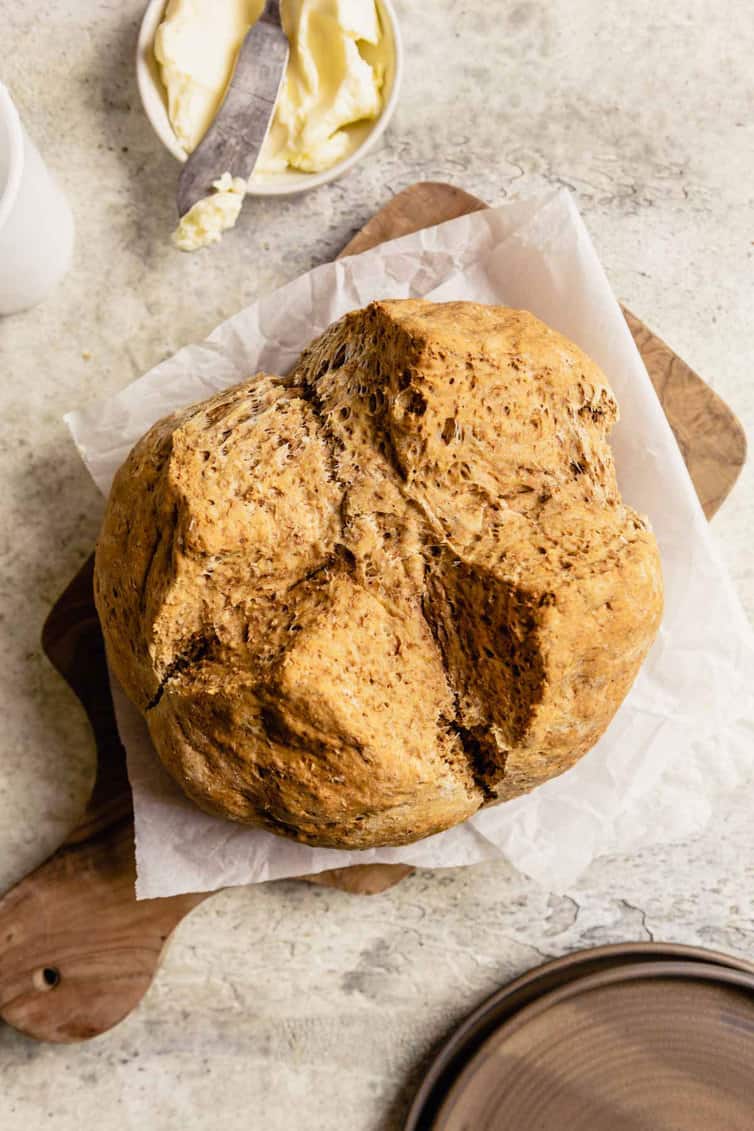
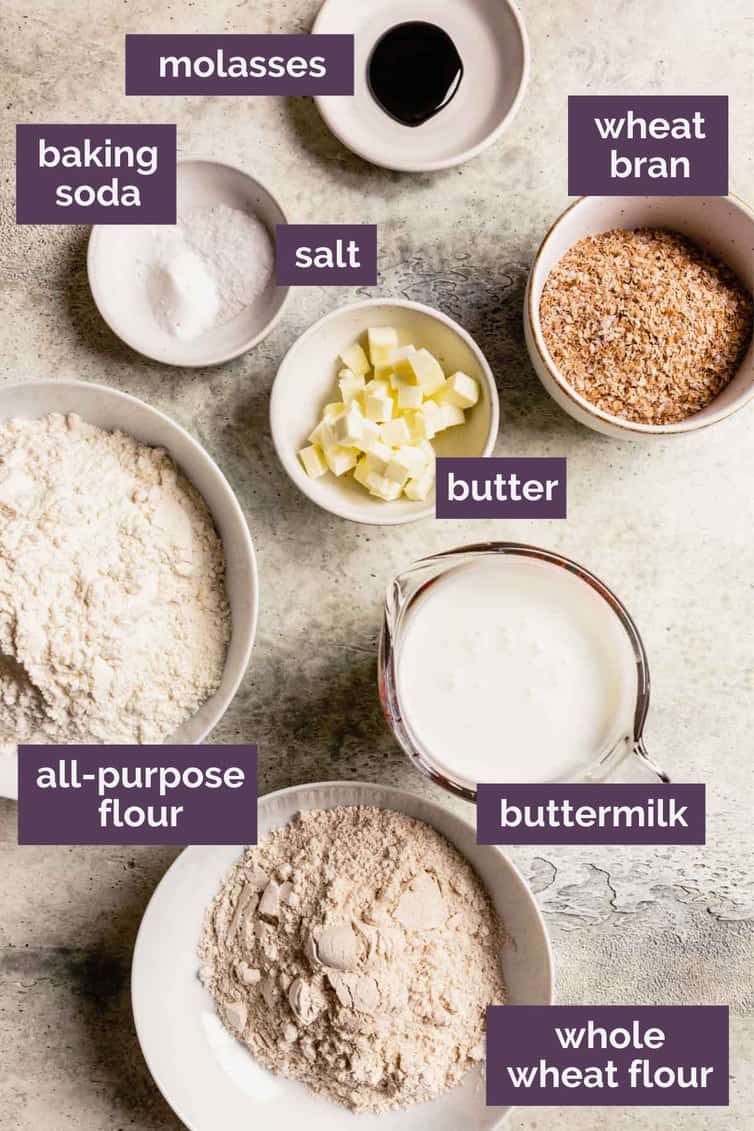
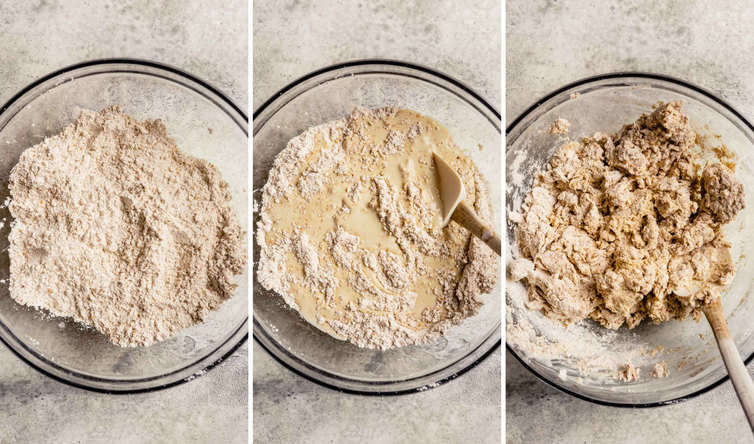
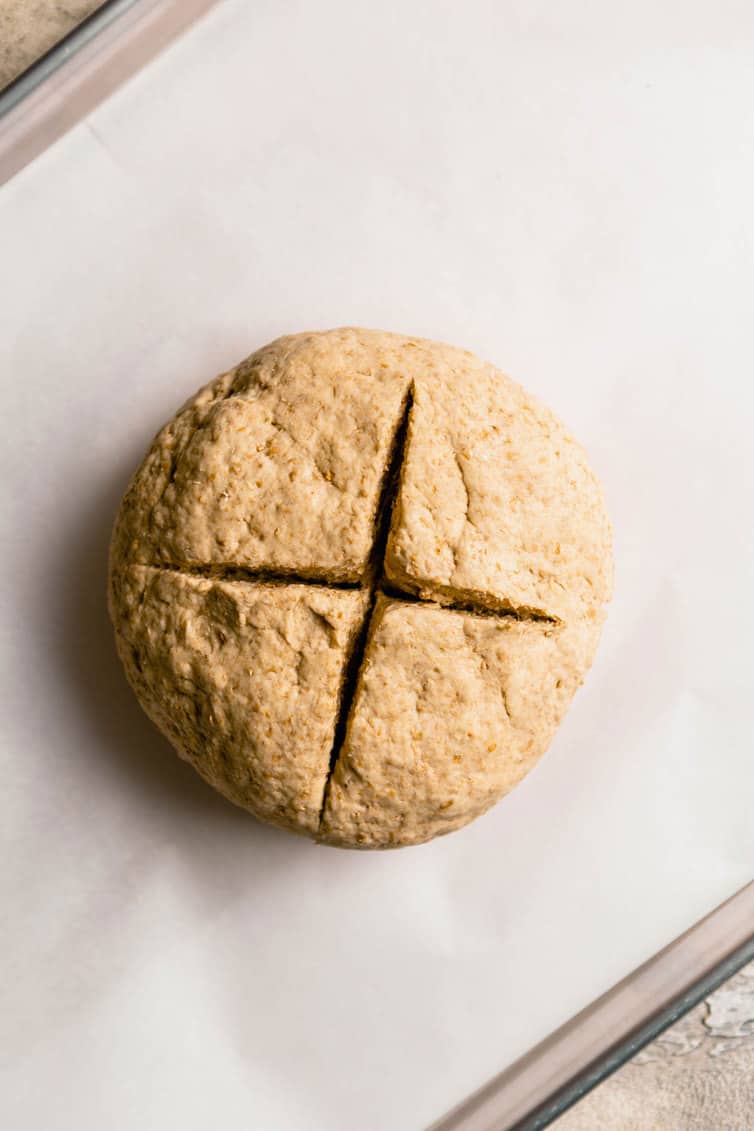
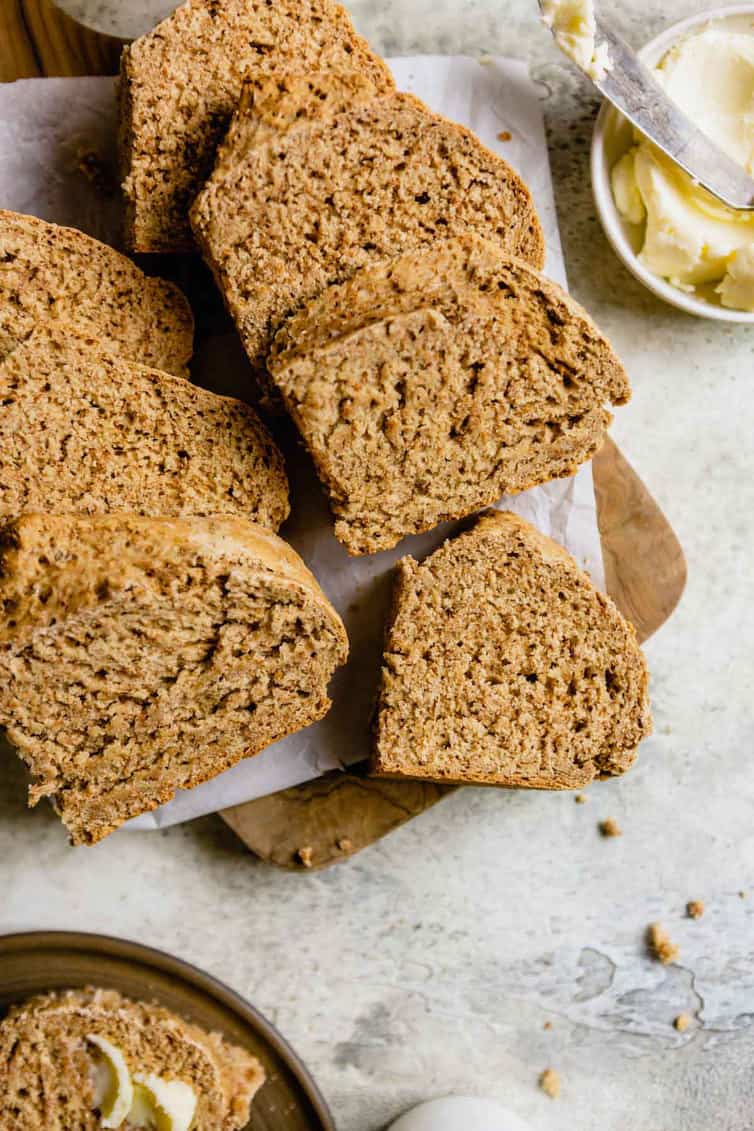
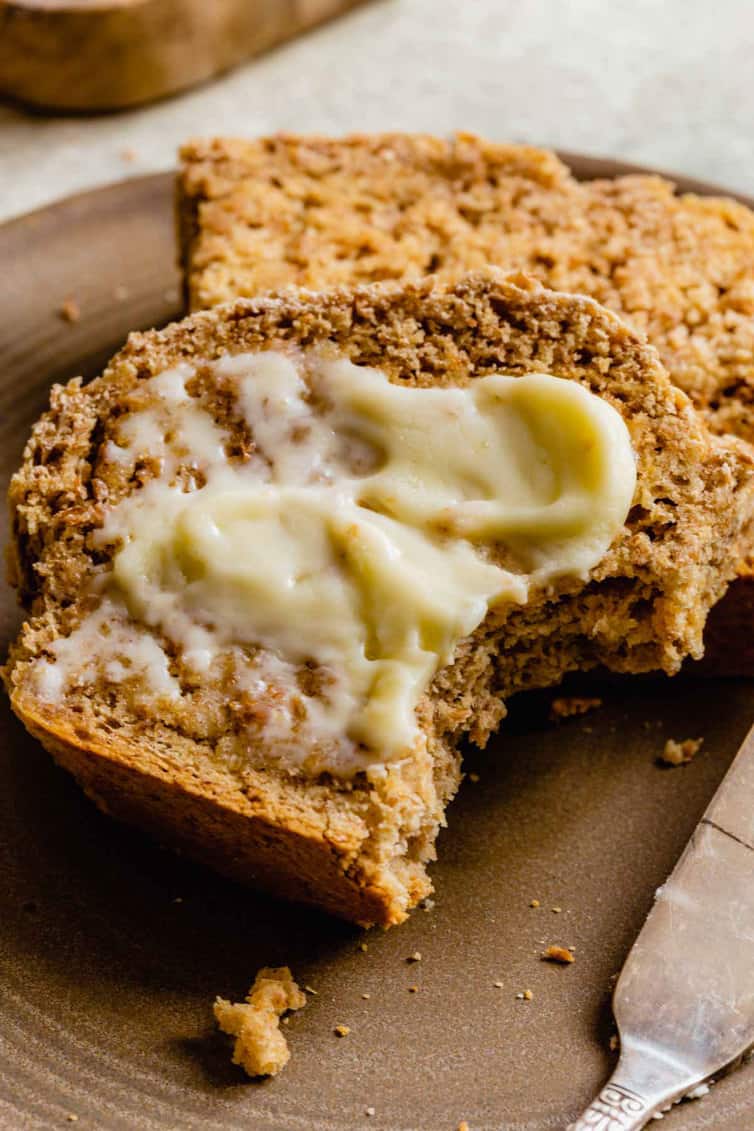



Made this bread and it looked just like the picture. Tasted fabulous! I am making again for my sister in law…thanks for a wonderful recipe!
This recipe is a waste of ingredients. Do not use this recipe!!!
There are not enough liquids to hold the loaf together. I had to add buttermilk twice just to get it to form a ball. I finally got it out of the oven after more than 40 minutes and when we cut into it, half the loaf was still raw. It’s now back in the oven, but I don’t hold out much hope and will probably have to bin the entire loaf.
This bread was terrible. It didn’t bake in the center and was very bitter. Flour and wheat germ were brand new, so it wasn’t that problem. I cooked it for double the time and still not cooked. Just overall dry and not a good recipe.
Thanks for the recipe! My dough was pretty dry and crumbly. Is that how it’s supposed to be?
so did mine … 1st attempt at bread so I have to wonder -user error? Is there something understood by people who have made bread which I am unaware? Total loss and that was said …lots of time and effort and now no bread for dinner.
My mom made bread like this but without the butter. Baked it a a large pan it had more of the texture of banana bread and was sweet. Loved it warm with lots of butter.
Great recipe! Just did a practice run before our St Patrick’s Day dinner with family coming from out of town tomorrow and the hubby and I loved it. Looking forward to having it with beef stew tomorrow night.
Used wheat germ instead of wheat bran per your substitution guidelines. Cooked for 35 minutes at 350, then waited one hour before cutting into it. Came out great.
Reading some other recipes for brown bread it seems that it may take a lot longer to cook if you don’t make the cuts as deep… not sure if that may have been an issue for some of the other people that tried it and it came out doughy.
Alternatively wondering if the variability in cooking times could be due to measuring the flours with cup measures vs weighing them… I weighed mine on my kitchen scale.
Cannot wait to try this recipe! I’ve been searching for a good one, ever since we traveled to Ireland. We spent several nights at Longueville House, and had the most amazing meals there! I am certain this will be amazing!
Five Stars!!
Hi Michelle, Thanks for sharing this recipe. It was the easiest and most delicious bread I’ve ever made!
I was a little confused by one of the comments about kneeding, then re-read your recipe and saw that only minor kneeding was necessary, whew! Based on another comment, I looked up what the internal temperature of what this type of bread should be… 200-205 degrees. It took about an hour for my bread to reach that them, but it came out perfect. We’ve been enjoying it toasted with butter, along with our soup. Again, excellent recipe. Thank you!!
I googled the temperature and it said 180 wonder which one is correct
FINALLY! The brown bread recipe I’ve been looking for! I’ve tried so many in my attempt to recreate the bread I fell for when visiting Ireland. It also reminds me a little of the bran muffins my grandmother used to make, so double win on pulling heartstrings with a recipe!
I, too, had trouble with the bake time. It took about an hour. I looked up what the internal temp should be and used my Thermapen to figure out when it was done, and boy, was I glad I did, or it would have ended up soggy in the middle, too.
Thanks, Michelle, for a terrific recipe!
Baked the bread for 45min. At 350 convection (which is 325 convection). Let it cool for 1hr and doughy insider he bread.
Unfortunate, it would be nice to have a video to see how you knead and how long.
I’m a beginner at making bread.
It certainly didn’t work for me. I put it in the stand up mixer and kneaded 5 min. Stop 2min. Gathered the flour and manually put it together and kneaded another 4 min in the stand up mixer.
Michelle, , what are your thoughts on using white whole wheat flour in place of whole wheat flour?
Hi Michelle, I think that would work just fine! Your loaf might just be lighter in color, but otherwise fine!
Bread is a love language💓😊
Thank you very much for this recipe. It did turn out very well and finished baking in 30 minutes at 350 degrees. To make up the 1/2 cup of other flours I used 2 tbsp of wheat germ 2 tbsp of wheat bran and 2 tbsp of rolled oats because that is what I had on hand. This really is a good recipe no doubt about it.
I can see where you could make minor changes to suit your own taste, for example I may use 2 tsp of molasses next time just to see how it taste. If you do use molasses make sure its fancy molasses the kind bought for breads and baking as the other ones are very strong. You could ever use 1 1/2 WW flour and 1 1/2 White flour, I have a feeling this recipe is very flexible.. Thanks again Anna from Vancouver, BC Canada formally Ennis County Clare..
Made it tonight in a pinch to accompany split pea soup for dinner. Very easy and turned out beautifully. I am guessing there is a good dose of fiber in this bread. My 8 year old was very happy with it and I wish we had honey on hand, it would have gone very well with this.
Hello,
This looks so delicious and very authentic! I am anxious to try it..just reading the recipe…I have wheat bran and wheat germ on hand..what proportion of those would I use in the recipe?
Thanks I will let you know how it turns out!
Hi Terri, You can use either one of those, or a combination in any proportions you choose.
Ansa- did it end up tasting like O’Connors?
Ok, I made this for St Patricks Day…and you know what….THIS WAS VERY GOOD..and very easy to make.
THANKS AGAIN…for a deliciously easy recipe that I will be making again!
Ansa
Mine keeps coming out doughy in the middle. I even baked it for an hour! What am I doing wrong?
Hi Jamie, Hmm. Do you have an oven thermometer? I’m wondering if the temp could be off. Also, are you waiting for the bread to cool before cutting into it? If you cut into still-warm bread, it will almost always result in doughy/gummy insides.
Thanks Michelle! I know my oven runs low, so I set the temperature higher than the recipe suggests and bake longer. But you know what? I was overly excited to break open that beautiful loaf. I didn’t wait an hour. That may be what it was!
I never heard of brown bread until my trip to Ireland 10 yrs ago.
I had brown bread every chance I could while I was there. I LOVE it.
I found a little Irish store that I could buy it here in Chicago…but I really wanted to try making it myself.
Im so glad you posted this because Ive been too intimidated to try making it myself.
This looks like a recipe I could handle.
THANK YOU.
Happy St Patrick’s Day!
Ansa
Wondering where the store in Chicago is?
O’Connor’s Market on Devon Avenue just west of Harlem (by the train tracks)
It has the BEST brown bread I ever had. They make it fresh!
Ansa
On my trip to Ireland I could not get enough of this bread. I have been thinking of baking at home for some time. Your post has inspired me. It is great with smoked salmon and some peppery arugala and capers. Yummy! Now all I need is a Guinness!
I’ve never seen the brown bread version of Irish soda bread before, but I’m definitely intrigued to try it!
It looks awesome! Can’t wait to try it!
I was obsessed with brown bread when I went to Ireland a few years back. It was moist and delicious! I’m trying this recipe tomorrow!! Yum!
Love a good Irish bread and I love how this one has whole wheat flour. Definitely need to try!
I ate Irish brown bread every day when we were on the Emerald Isle…so good! I’d love a slice of yours with butter and smoked salmon…heavenly!!!
Love the idea of changing up the original Irish soda bread to make it just a bit healthier!
With a good hearty stew, this bread would be the perfect rainy day meal! I have bookmarked it for a Spring day soon!
I love the smell of baking bread. I bet this taste amazing warm from the oven!
Looks wonderful! Though I didn’t make any from scratch this year, I did buy some from my local and awesome bakery — Zingerman’s here in Michigan. I used their version of Irish Soda Bread for a Guinness Chocolate Bread Pudding I made a couple days ago. Yours looks like it turned out quite well. I agree with you, I love the chewy and hearty texture this type of bread produces. Yum.
Looks so easy! A definite must try.
Love this.
And I totally agree on Irish Soda Bread – it’s so satisfyingly simple. Perfect for sweet or savory preparations.
Thanks so much for the lovely post!
This looks awesome! I love bread, so I’ll for sure be trying it. :)
Oh I couldn’t agree with you more on the butter and jam on soda bread! One of my favorite things from my childhood was doing that when my mom made soda bread. This Irish brown bread looks amazing…I need to try it!
Yum! I’m such a bad bread baker. Gotta get over that and make this!
I love this bread! I made it when David blogged about it. His culinary adventures in Ireland made me want to go so badly! Last time I made this, I left out the germ/bran since I didn’t have any and hand, but I recently picked up some wheat germ for another recipe (and buttermilk, luckily), so i will have to make this again! Thanks!
Brown Bread is one of those things I absolutely fell in love with when I was in Ireland. I miss it terribly, but now I can make it myself at home! :)
Now I want stew & this bread! Or maybe just a nice, thick slice toasted with some honey on top! Yeah, think I need to make this one :D
That looks great. I saw your suggestions, but what have you been pairing it with?
Looks wonderful!
I made Irish Brown Bread maybe two years ago, and my recipe is SO different than yours! It cracks me up when there are 20 different ways to make something the way it should be made. Your version sounds delightful, and I definitely need to give it a go. We’re having company in two weeks, and I think this would be great for breakfast.
Great bread recipe!
Yum! This looks super awesome! Great recipe :)
It looks absolutely stunning! I’d recommend some Blackcurrant conserve over some good real butter to set it right off, or a lick of butter with some strong red cheddar. Can’t be beat!
This looks delicious! I’ll have to try it soon!